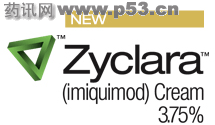2010年3月26日,Graceway药业宣布,美国食品药品管理局(FDA)已批准3.75%的Zyclara(咪喹莫特)乳膏适用于免疫系统功能正常的成人,作为临床上典型的、肉眼可见或可触及的光化性角化病(AK)的局部治疗药物。该疗法可用于大面积的皮肤,包括整个面部或秃顶的头皮。Zyclara被视为一种免疫反应调节剂。
在临床试验中,患者在基线时平均有11处AK。经Zyclara治疗后,AK的病损总数减少82%。36%患者的所有AK(包括治疗过程中发现的病损)均得到彻底清除,而安慰剂对照组患者中仅有6%达到这种效果。Zyclara治疗组达到部分清除的患者率为59%,而安慰剂对照组占23%。另外,40%以上的医生报告使用Zyclara“显著改善了”患者皮肤的外观。
此外,研究中逾85%的患者在开始Zyclara治疗后出现AK病损数增加(据Graceway称,若皮肤表面存在肉眼可见的AK,则很可能皮肤表面之下会存在更多的AK)。临床试验中的清除率反映的是对基线时肉眼可见的病损以及对治疗过程中发现的新病损的治疗。
在临床试验中,实施2周的治疗周期方案过程中使用Zyclara最常见的重度局部皮肤反应为红斑(25%)、结痂(14%)、溃疡(11%)以及剥落、脱皮和皮肤干燥(8%)。据厂家称,局部皮肤反应(如红斑)与治疗效应一致。
Zyclara适宜在加速的6周给药周期中作为日常用药,该周期由2周日常用药、2周非治疗期及随后的2周日常用药组成。Zyclara的市售形式为28小袋构成的一个包装,每小袋含250 mg乳膏,为单次使用量。预计该产品于2010年5月在。
Graceway Pharmaceuticals
Pharmacological Class:
Immune response modifier
Active Ingredient(s):
Imiquimod 3.75%; topical cream; contains parabens.
Indication(s):
Actinic keratoses on face and balding scalp in immunocompetent patients.
Pharmacology:
Actinic keratosis is a precancerous skin condition that results from long-term exposure to harmful UV rays. The lesions are small, reddish, sometimes scaly or rough, and often appear in areas exposed to the sun. Some may develop into squamous cell carcinoma.
The mechanism of action of imiquimod in treating actinic keratoses is not known. It activates immune cells, and the topical application of 5% imiquimod was shown to increase markers for cytokines and immune cells (eg, CD3, CD4, CD8, CD11c, CD68).
This formulation is indicated for treating palpable or visible actinic keratosis lesions on the face or balding scalp. Where there are visible lesions, often there are more lesions just below the surface of the skin. These may berevealed during therapy. Zyclara treats both extant and newly revealed lesions.
Clinical Trials:
Two double-blind, randomized, vehicle-controlled studies were conducted that involved 319 subjects with actinic keratosis. The studies enrolled Caucasian adults with 5 to 20 typical visible or palpable lesions on the face or scalp. The study cream was applied to either the entire face or balding scalp once daily for 2 weeks, then no treatment for 2 weeks, then one more 2-week treatment period. During an 8-week follow-up period, patients returned for clinical observation and monitoring. Efficacy was assessed by total (baseline and newly revealed) lesion counts at the 8-week post-treatment visit. Complete clearance required absence of any lesions. Partial clearance was defined as the percentage of patients in whom the number of baseline lesions was reduced by at least 75%, and the rate was measured relative to the baseline lesion count.
In Study 1, 25.9% of patients using the active drug experienced a complete clearance, compared to 2.5% for vehicle; 45.7% of patients on the study drug had a partial clearance, compared to 18.8% for vehicle. In Study 2, 45.6% of patients given the study drug experienced a complete clearance, and 73.4% had a partial clearance, compared to 10.1% and 26.6% for vehicle, respectively.
Legal Classification:
Rx
Adults:
≥18yrs: Apply thin film to affected area (face or balding scalp) and rub in once daily at bedtime; leave on for 8 hours, wash off with mild soap and water. Treat for two 2-week cycles separated by a 2-week no-treatment cycle. Max two packets per application and one treatment course per area. Apply to intact skin only; Interrupt if severe reaction occurs; do not extend treatment cycle due to missed doses or rest periods. Wash hands before/after application.
Children:
<18yrs: not recommended.
Warnings/Precautions:
Immunosuppressed. Auto-immune conditions. Not for treating xeroderma pigmentosum, superficial basal cell carcinoma, external genital warts. Sun sensitivity. Avoid eyes, lips, nose, mouth, mucous membranes, sun or UV light (use sunscreen daily). Do not occlude. Pregnancy (Cat.C). Nursing mothers.
Interaction(s):
Avoid concomitant other forms of imiquimod.
Adverse Reaction(s):
Local inflammation (eg, erythema, crusting, erosion, weeping, edema), pruritus, flaking, scaling, dryness, flu-like symptoms (eg, headache, fatigue, nausea, fever, chills, myalgia), transient increase in lesion counts; exacerbation of skin inflammatory conditions (eg, graft vs. host disease), chest pain, lymphadenopathy, hypo- or hyperpigmentation.
How Supplied:
Single-use packets—28
Last Updated:
4/29/2010



